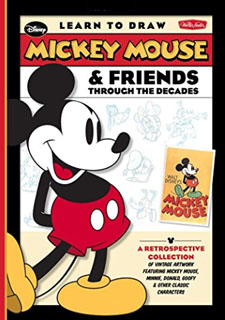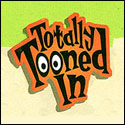I interrupt my website to actually write a post myself – and to take a moment to thank our regular contributors past and present for keeping this space lively, informative and fun. I’m having a blast reading these posts everyday and I hope you are too. As for today, here are three books that recently came my way, all of them excellent additions to the bookshelf, that I think you should know about.
 Toons In Toyland: The Story of Cartoon Character Merchandising by Tim Hollis, is one of those books you pick up and you just can’t put down. Over 300 pages profusely illustrated with color images of the coolest vintage animated and comic strip toys, games, records, books and assorted merch. All of it is from Hollis’ extensive personal collection and its the next best thing to having this material yourself – and it takes up a lot less space.
Toons In Toyland: The Story of Cartoon Character Merchandising by Tim Hollis, is one of those books you pick up and you just can’t put down. Over 300 pages profusely illustrated with color images of the coolest vintage animated and comic strip toys, games, records, books and assorted merch. All of it is from Hollis’ extensive personal collection and its the next best thing to having this material yourself – and it takes up a lot less space.
The book itself – the writing – is excellent. A thorough telling of the story of how character merchandising came to be, Hollis begins with The Yellow Kid, Katzenjammer Kids and Buster Brown and proceeds to cover all bases. Hollis gets into the details of not only the characters being merchandised, but the people and companies who did the merchandising. Baby Boomers please note – Hollis spends the majority of the book on the stuff we care about most, from the 1940s-50s and 60s.
His various chapters cover, individually, such diverse subjects as children’s books, records, home movies, character-based locations (theme parks, roadside diners, etc), all the numerous food items – and much, much more. Seriously, I think he’s covered it all. The book drips with the author’s enthusiasm – it’s an absolute joy, a treat, and had me smiling from cover to cover. Buy this.
 Service With Character: The Disney Studio & World War II by David Lesjak. No one knows more about Disney’s wartime merchandising, insignia and ephemera than author Lesjak. He’s spent years researching the subject and tracking down the rare material of which he writes. Now he puts it down for the permanent record, in a book that surveys all the work – most of it previously ignored, discarded or forgotten – the Walt Disney studio produced during between 1941 and 1945 for the war effort.
Service With Character: The Disney Studio & World War II by David Lesjak. No one knows more about Disney’s wartime merchandising, insignia and ephemera than author Lesjak. He’s spent years researching the subject and tracking down the rare material of which he writes. Now he puts it down for the permanent record, in a book that surveys all the work – most of it previously ignored, discarded or forgotten – the Walt Disney studio produced during between 1941 and 1945 for the war effort.
Quoting many letters, newspaper clippings and much internal business correspondence, Lesjak tracks what the studio created for the U.S. and Canadian governments, merchandisers, the home front and military – much of this previously unknown to me. Der Fuerher’s Face was just the tip of the iceberg! The Gremlins are thoroughly discussed, and the various insignia is detailed – as well as much information on artist Hank Porter. Comics, training films, various art for posters, print media and propaganda – all examined here. An important record that many of us have been dreaming about for years – here it is at last.
Only two quibbles – #1 The book has no index, and it really needs one. Hopefully that’ll be corrected in a future edition. #2 The book contains no images. Because this tome is totally unauthorized, the publisher (Theme Park Press) did not want to face the wrath of Mickey’s legal team. There are numerous links to an online source where all the visuals are available to view. This is a bit awkward – but better than nothing. The information contained in the book is so vital I can overlook both quibbles and recommend it highly to any one interested in Disney, and particularly the wartime years.
 Learn to Draw Mickey Mouse & Friends Through the Decades by David Gerstein, illustrated by John Loter. I ran across this book – the latest in a series of Disney Learn-To-Draw books published by Walter Foster – at my local comics shop and gave it a look. I was quickly hooked when I saw the end papers were a collage of vintage 1930s Mickey Mouse theatrical one-sheets. Then I noted the byline of David Gerstein and I knew this wasn’t going to be an ordinary “How-To” book for aspiring cartoonists.
Learn to Draw Mickey Mouse & Friends Through the Decades by David Gerstein, illustrated by John Loter. I ran across this book – the latest in a series of Disney Learn-To-Draw books published by Walter Foster – at my local comics shop and gave it a look. I was quickly hooked when I saw the end papers were a collage of vintage 1930s Mickey Mouse theatrical one-sheets. Then I noted the byline of David Gerstein and I knew this wasn’t going to be an ordinary “How-To” book for aspiring cartoonists.
Oh sure, there are numerous spreads that explain in simple steps how to draw Mickey, Pluto, Minnie, Goofy, and Donald (the standard characters) – not to mention Daisy, Pete (Peg-Leg Pete to you), Huey Dewey and Louie – but, as usual, Gerstein crams the edges of his books with archival materials – subversively indoctrinating eager young artists with historical propaganda that might accidentally (and accurately) explain the origins of these popular characters.
In the simplest of terms (and the choicest of rare visuals – including model sheets, storyboards, behind the scenes photos and frame grabs) Gerstein explains the story of Mickey Mouse, his personality, and his evolution throughout the years. Same with Pete, Minnie and the whole Duckberg clan. My favorite thing in the book, is a breakdown of the classic Mickey pose – the one on the cover (above) with his hand behind his back and one foot raised. Gerstein isolates the two frames from Puppy Love (1933) – drawn by Fred Moore – where that iconic image actually came from. I’ve always wanted to see that in print somewhere! (See those frames for yourself by freezing the shot at 5:34 in the embed of Puppy Love below).
It’s minutiae like this that make this Walter Foster art book a must-have. Buy one for yourself and buy another for the kid, the niece, the nephew, or the Huey, Dewey and Louie in your life. Highly Recommended!


 Jerry Beck is a writer, animation producer, college professor and author of more than 15 books on animation history. He is a former studio exec with Nickelodeon Movies and Disney, and has written for The Hollywood Reporter and Variety. He has curated cartoons for DVD and blu-ray compilations and has lent his expertise to dozens of bonus documentaries and audio commentaries on such. Beck is currently on the faculty of Cal Arts in Valencia, UCLA in Westwood and Woodbury University in Burbank – teaching animation history. More about Jerry Beck [
Jerry Beck is a writer, animation producer, college professor and author of more than 15 books on animation history. He is a former studio exec with Nickelodeon Movies and Disney, and has written for The Hollywood Reporter and Variety. He has curated cartoons for DVD and blu-ray compilations and has lent his expertise to dozens of bonus documentaries and audio commentaries on such. Beck is currently on the faculty of Cal Arts in Valencia, UCLA in Westwood and Woodbury University in Burbank – teaching animation history. More about Jerry Beck [







So Mickey’s hands really aren’t be hind his back; they’re in his pockets!
I saw that Mickey Mouse book in Barnes and Noble the other day and it looked awesome! I think I’ll get it!
The Kindle version of Service With Characters contains a lot of images, and the author has a Facebook page where he posts photos and documents. I agree with you that it is a great book, maybe even better than the one published recently by Disney himself.